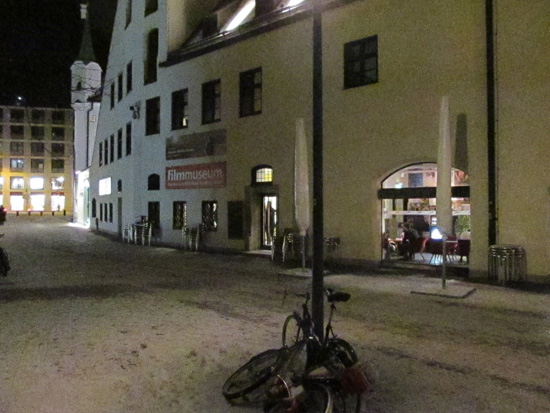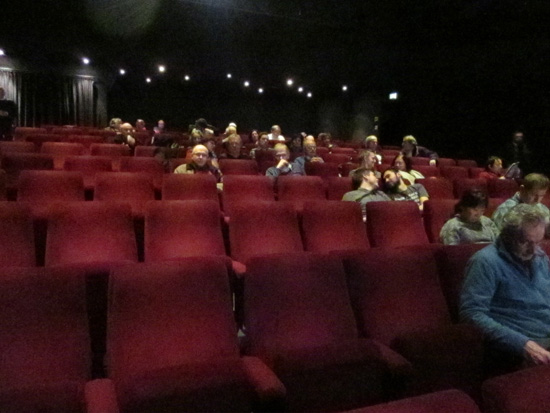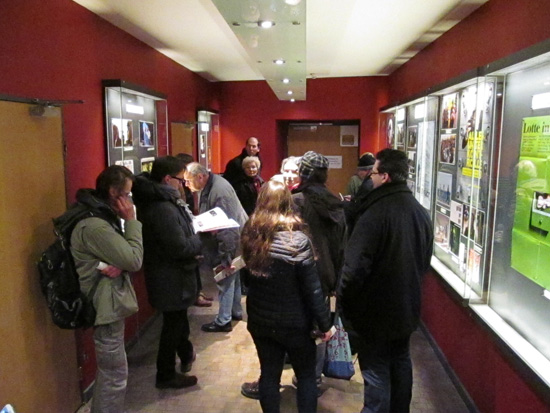Welcome to “This is Cinerama” |
Read more at in70mm.com The 70mm Newsletter |
| Written and photographed by: Anders M Olsson, Lund Sweden | Date: 24.01.2017 |
 The Film Museum in Munich. The Film Museum in Munich.Good evening Ladies and Gentlemen, and welcome to tonight’s screening of “This is Cinerama”, the film that shook the motion picture business to its foundations. My name is Anders Olsson, I’m from Sweden, and I have a background of working with various aspects of film distribution, translation and exhibition, mainly in the 1970’s and 80’s. But most of all, I’m a Cinerama “addict”. Some of you may have read in the printed program or on the web that tonight’s film was going to be introduced by its director of restoration David Strohmaier. Well, unfortunately David couldn’t come, so he suggested me as his replacement. Thank you Dave, I hope I can live up to your expectations! I think David may be excused, since he is busy supervising the scanning of the original three strip negatives of “Windjammer”, a film that was extremely popular here in Germany, so popular in fact that German filmmakers decided to make their own sequel; “Flying Clipper - Traumreise unter weißen Segeln”. When I was seven years old in 1961, my mother took me to the Royal Cinema in Malmö, Sweden, where I saw “Seven Wonders of the World” in Cinerama. That film made a lasting impression on me. Like most Cinerama-films, it started with a 4 by 3 prologue on a small screen. But after the prologue, the screen grew, and grew, and grew, until the picture almost filled the entire wall of the cinema. You can imagine me, a seven-year old boy, sitting there with big eyes and dropped jaw. That was the only Cinerama-film I saw as a kid and, from that moment on, every visit to the movies was a big disappointment. I never could forget Cinerama, but it took me almost 40 years before I had a chance to see it again. That was at the Museum of Film, Photography and Television in Bradford, England, which has one of only a handful remaining genuine Cinerama installations in the world. The museum, today renamed as the National Media Museum, runs an annual film festival dedicated to Cinerama and other big screen formats. The next time will be in October. |
More in 70mm reading: Cinema like never before in Munich, Germany Welcome to “Cinerama Adventure” Cinerama's 50th Anniversary Cinerama Remaster in70mm.com's Cinerama page Internet link: |
 Some of the 45 people who came to see "This is Cinerama". Some of the 45 people who came to see "This is Cinerama".Cinerama is the “mother” of all modern widescreen formats. There had been attempts before to make widescreen films. Some say that they failed because the time was not right, but the early widescreen films from around 1930 lacked two very important elements which Cinerama added - colour and multi-channel high fidelity sound. Fred Waller, an American inventor, had for many years been interested in what makes us perceive the world around us as real. His conclusions were that it is the peripheral vision, what we see in the corner of our eyes, that’s most important. Fred Waller wanted to record reality on film, that is, the entire human field of vision. The only way he could think of to do that was to use several synchronized film cameras, each catching only a small part of the total vista. One of his experimental set-ups used as much as eleven synchronized cameras, and just as many projectors to show the film. The finished commercial product used three cameras or - more correctly - one camera that was actually three cameras in one. So you would use three synchronized strips of film in the camera, and run the film on three projectors, each showing one third of the complete picture on a deeply curved screen. In addition, the sound had its own film strip, so there were really four pieces of film running simultaneously. Typically six or more projectionists were needed to run a Cinerama-film. When you see an ordinary film, and the camera moves forward, for example in a street, everything you pass will just vanish at the sides, out of the picture. But with Cinerama, you will see what’s going on to the left and right of the camera. Let’s say that there’s an open gate in one of the street houses. As the camera passes, you can look through the gateway, and into the back yard behind it. Sadly, we don’t have any equipment here at the Film Museum to run three-strip films, and even if we did, it would have been very difficult to find a surviving print in good enough condition. So we will have to make do with a digitally restored print on a single projector. But you will still see the same panorama as at the premiere in 1952, and you will see a hint of the two join lines which reveal that the film was originally shot on three separate pieces of film. If this had been a real Cinerama-theatre, the screen would have gone from floor to ceiling, stretching from there to there [demonstration], so the front rows would actually have been inside the curvature of the screen. Obviously, our screen is flat and much smaller, but digital magic will make it look curved. I must say a few words about the film’s host and narrator, Lowell Thomas. There are probably few Germans today who have heard of him. He was in his time one of the most well-known radio voices in the U.S.A. He was a globetrotting reporter, lecturer, film-maker, news anchor and the author of more than 50 books. His most remarkable achievement was probably that he discovered Lawrence of Arabia, and made him famous. |
|
 Queuing up for "Cinerama Adventure". Queuing up for "Cinerama Adventure".Cinerama has sometimes been described as the eighth wonder of the world. But I’d like to add that the greatest wonder is perhaps that this film, against all odds, still exists and has been restored. For that, we can thank David Strohmaier and his team who have been tirelessly working through the past decade to restore the library of Cinerama films, all at an impossibly low budget. If this film has whetted your appetite for Cinerama, you’ll be pleased to know that four weeks from now, on February 5, the Film Museum will show the second Cinerama feature, “Cinerama Holiday”. While “This is Cinerama” was mainly made to show off the Cinerama system, “Cinerama Holiday” also proved that Cinerama could tell an interesting story. “This is Cinerama” comes in two acts with an intermission that was originally necessary for the projectionists to change the reels. Today, digital technology might have done away with that. But to make the performance as historically accurate as possible, and out of respect for the original film-makers, we will still follow the original procedure. The first act plays for 1 hour and 5 minutes, after which there will be a 15 minute break. The second act will run for slightly less than an hour. If you find parts of the first act a little slow, with a church choir singing hymns and a lengthy opera sequence from Aida, you will be more than compensated in the second act by some exciting water-skiing and a breath-taking flight across the United States. Now, let’s pretend that we are all sitting at the Broadway Theatre in New York, in the evening of September 30th, 1952. Until now, we’ve been used to seeing films on a fairly small, almost square screen, with the sound coming from a single speaker. Boy, are we in for a surprise! Enjoy the show! • Go to Cinema like never before in Munich, Germany • Go to Welcome to “Cinerama Adventure” |
|
| Go: back - top - back issues - news index Updated 21-01-24 |
